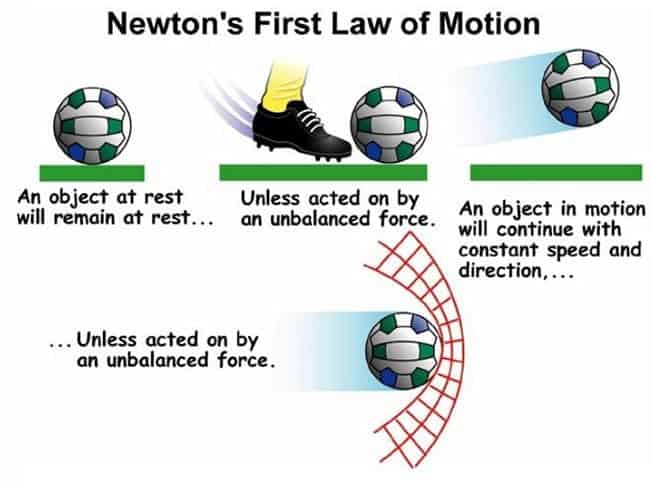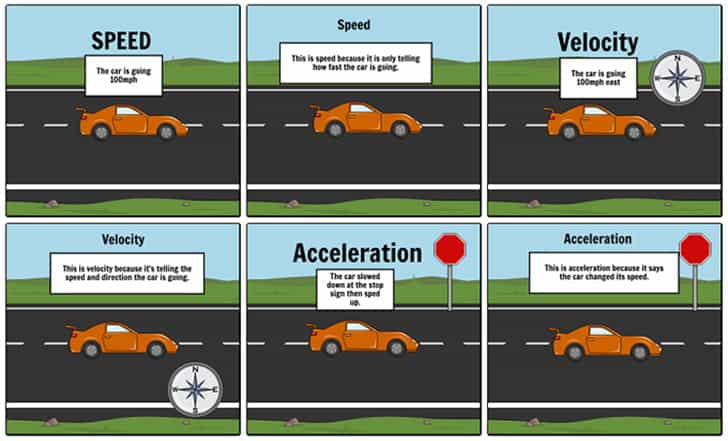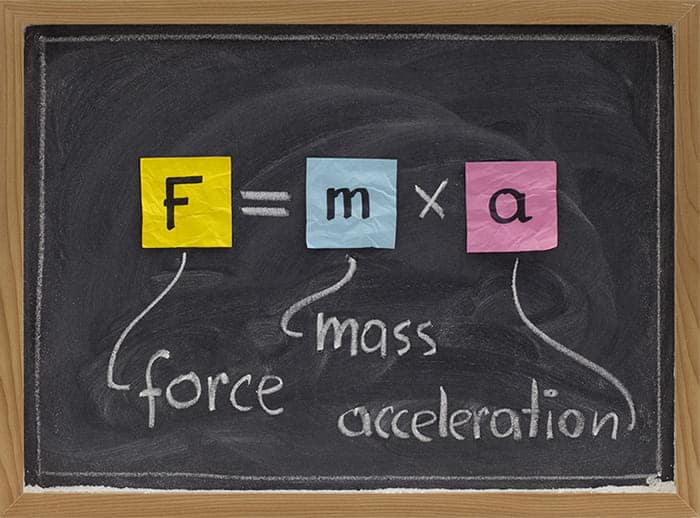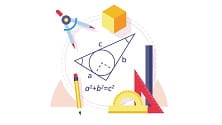Change is hard, we all know it. And we don’t mean that in a purely psychological sense. Did you know that is one of the fundamental laws of the universe? Resistance to change even has a name – inertia, and it’s a very important topic in physics. Let’s explore all about it in this super simple, but effective experiment.
Article Contents
1. What is inertia exactly?2. What is motion and properties that describe a movement
3. Principles of Newton’s laws of motion
4. Materials needed for demonstrating inertia
5. Instructions for demonstrating inertia
5.1. Explanation of the Inertia Experiment – Why does it jump upwards?
6. What will you develop and learn
What is inertia exactly?
People used to think that objects have a natural tendency to stop. If you want them to continue moving, you have to apply some kind of force again. And that is something that we can observe in everyday life as well. If we throw a ball, it won’t just keep on moving forever. It will fall down on the ground. Everything will stop eventually.
But that notion was challenged in the 1600s by Galileo, and later, Newton and Descartes. Galileo was studying planetal orbits and noticed something strange. Objects will actually continue to move unless some force causes them to stop. This discovery helped to explain how is it possible that we don’t feel any motion even though Earth revolves around the Sun. We are moving together with Earth so from our perspective, it looks like it stands still.
Sometimes we can observe a similar effect on a smooth ride. If we don’t see or hear anything, it would be hard to say if we are actually moving or standing. That new insight was called the Law of Inertia.
Inertia is defined as the object’s tendency to continue doing what it was doing – if it was moving to continue to move and if it was resting to continue resting. This second part does align with our everyday life – objects don’t start moving by themselves. But we all know objects eventually stop. So how can this be true?
But here comes the caveat – they will continue what they were doing unless acted upon by some net force. The net force is just the sum of all the forces that act on an object. Our environment interacts with us in various ways and there are a lot of acting forces. Friction and gravity being the most obvious.

When we roll a ball it will come to a stop because of the friction. If there was no friction it would continue to move (unless acted upon by some other unbalanced force). We can notice that by comparing surfaces with different levels of friction. For example, ground and grass produce much more friction when the ball rolls, so the ball will stop sooner. Ice, on the other hand, would cause the ball to roll much, much longer. If there was no friction at all, like in a vacuum, the ball would never stop. And that’s actually true in the space!
All objects resist change, but the bigger they are (the more mass they have), the harder it is to change. We know that intuitively. We know that it’s harder to move (and stop!) a huge boulder than a tennis ball.
What is motion and properties that describe a movement
Motion is one of the key topics in physics. And no wonder, since it’s fair to say that everything in our universe is constantly in motion. Science of motion answers so many important questions. Like where you are, where you have been and where are you going.
Motion can be one-dimensional, for example, a car going in a straight line. Or it can be multidimensional – like submarine who can also move up and down.
We can define motion as a change in the position of some object in a certain amount of time. Besides distance and time, there are some other properties that describe motion.
When talking about a change in position, there are two important terms: distance and displacement.
Distance is a scalar quantity. It tells us the total amount of travel from the start position to the end position. All changes in position are added together, no matter the direction. If we walk 50m west and then 20m back east, our total distance will be 70m.
Displacement is a vector quantity. It takes into consideration direction, so in the same example, our total displacement will be 30m west. If the object travels in a straight line in just one direction, distance and displacement will be of the same amount. We should always preserve direction when talking about displacement though!
A similar case is with speed (scalar) and velocity (vector). Speed tells us how fast the object is moving, and its formula is the distance over time. Velocity is similar to speed, but with direction.
Unlike speed which is interested in the total distance you traveled in a certain time, velocity cares for displacement (change in position). If there is no displacement, for example, you move left 10 steps and then right 10 steps, you still moved with some non-zero speed. However, your velocity will be zero.

The last important term is acceleration. Acceleration is the change in velocity and we perceive it as speeding up or slowing down. Since velocity also includes direction, even change in direction is considered acceleration. What’s tricky about acceleration is that we often confuse it with velocity or speed. If something is moving very fast, it has to have a high acceleration, right? No, actually. The only thing that matters is if there is a change in velocity (speed or direction).
Principles of Newton’s laws of motion
Philosophiae Naturalis Principia Mathematica was published in 1687. It’s Isaac Newton’s life work and one of the most influential books in the history of mankind. It proposed fundamental laws of motion that are still in use today. Usually called Newton’s Laws of Motion, they changed the way we perceive the world and are the foundation of classical mechanics (sometimes even called Newtonian Physics).
There are 3 of them, usually called just First, Second and Third Newton’s law. Good news, you already know everything about the First law. Newton took Galileo’s Law of inertia and rephrased it. To be fair, he did give credit to Galileo. It states that “A body at rest will remain at rest, and a body in motion will remain in motion unless it is acted upon by an external force.”
The Second Law of Motion describes what happens to an object when it is acted upon by an external force. It’s defined as “The force acting on an object is equal to the mass of that object times its acceleration.” You probably know famous formula F = m * a, which describes this law. Even the First law can be derived from this formula, it’s the special case when acceleration is 0. No change in velocity means there was no force.

The Third Law of Motion states, “For every action, there is an equal and opposite reaction.” It’s also descriptively known as Law of action and reaction. When there is an interaction between bodies, they apply symmetrical forces to each other. Same in magnitude, but opposite in direction. A good example is launching the spacecraft and you can even test it out for yourself by building a homemade rocket using vinegar and baking soda, or by making a rocket using the matches.
Materials needed for demonstrating inertia

- Bigger empty cup, ideally transparent
- Chain of beads (we used simple beaded Christmas garland)
Instructions for demonstrating inertia
We have a video on how to demonstrate inertia at the start of the article or continue reading instructions below if you prefer step by step text guide.
- Put the chain of beads in the cup slowly so it doesn’t get entangled.
- Raise the cup from the ground and pull slightly on the chain’s end.
- Enjoy the show! 🙂
Explanation of the Inertia Experiment – Why does it jump upwards?
What is this sorcery? How are beads defying gravity?
The phenomenon of “chain fountain” caught the public’s attention when it was showcased in a YouTube video by Stephen Mould in 2013. It caused lots of attention and research in the physics community. The key is in the structure of the chain and the fact that beads are connected to each other.
When pulled upward, links connecting the beads rotate, and beads bump into each other. This produces a huge downward force on the opposite end of the chain. That, as we know from Third Newton’s law means that the opposite force of equal magnitude is created. So our seemingly small pull generates huge push from the other side of the chain which causes beads to go upward.
What will you develop and learn
- What is inertia
- Properties of motion
- Newton’s laws of motion
- That science is fun! 🙂
If you liked this activity and are interested in more physics experiments, we recommend exploring heat conduction or try crushing can with air pressure. Sounds cool? It really is. If you want to just sit and think in peace, we have you covered. Hanoi tower is an ancient puzzle that will surely challenge your logical thinking (and patience!). Learn how to make your own Hanoi tower and even how to solve it.
If you’re searching for some great STEM Activities for Kids and Child development tips, you’re in the right place! Check the Categories below to find the right activity for you.

STEM Science
Videos, guides and explanations about STEM Science in a step-by-step way with materials you probably already have at your home. Find new Science ideas.
Read more
STEM Technology
Videos, guides and explanations about STEM Technology in a step-by-step way with materials you probably already have at your home. Find new Technology ideas.
Read more
STEM Engineering
Videos, guides and explanations about STEM Engineering in a step-by-step way with materials you probably already have at your home. New Engineering ideas!
Read more
STEM Math
Videos, guides and explanations about STEM Math in a step-by-step way with materials you probably already have at your home. Find new Mathematics ideas.
Read more
Psychology
Find out all about development psychology topics that you always wanted to know. Here are articles from child psychology and development psychology overall.
Read more
First year of Child’s Life
Following a Child’s development every month from its birth. Personal experiences and tips on how to cope with challenges that you will face in parenting.
Read more
One thought on “What is Inertia and how to demonstrate it”